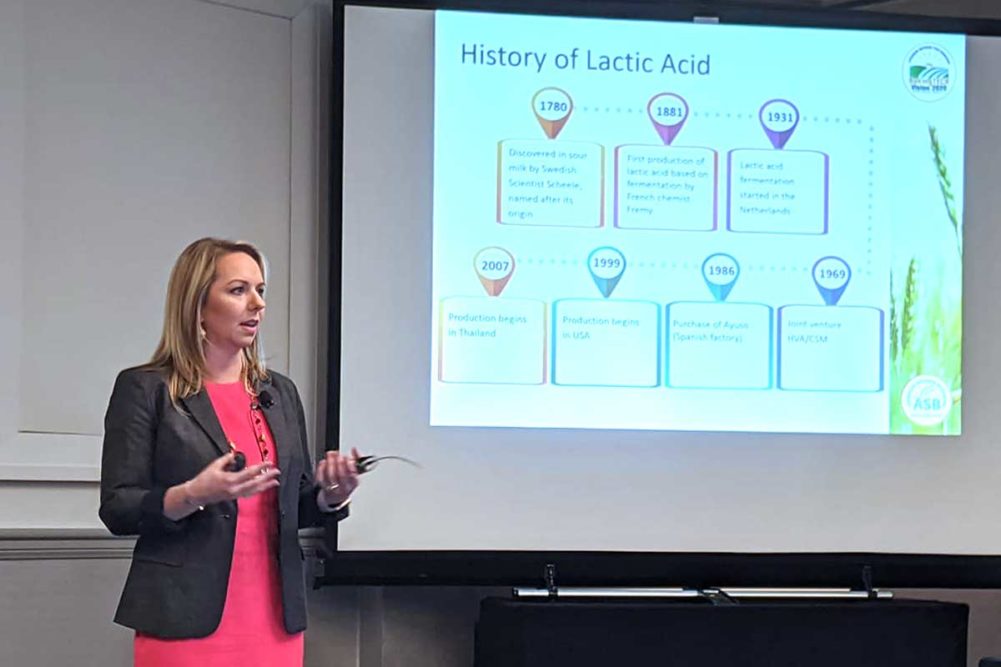Fermentation is all the rage with consumers interested in the benefits of fermented foods and beverages. Benefiting from that is sourdough and lactic acid, the baking industry’s own fermentation powerhouse. With interest in fermentation growing and the clean label trend persisting, lactic acid can provide bakers with several benefits. Kathy Sargent, strategic innovation director, Corbion, explained the basic science behind lactic acid and how it can benefit baked foods, specifically regarding preservation, during the education session “Lactic Acid: A Safe, Label Friendly Way to Reduce pH in Baked Goods” at the American Society of Baking’s BakingTech 2020.
“Fermented foods are very popular right now, whether that’s sauerkraut, fermented drinks like koumbucha,” she said. “All of that lactic acid is contributing to the benefits to your health and the digestibility.”
When flour and water are combined, lactic acid bacteria is a part of the system that develops to create the fermentation process. It’s naturally present in baked foods and also the human body, so it’s easy for people’s digestive systems to break down, making it an appealing ingredient. It also has several functions and benefits to baked foods while also being an ingredient consumers consider natural. It’s safe and non-toxic. It can be effective in reducing pathogens as well as pH, and it easily degrades, giving it a low environmental impact.
While lactic acid has a range of uses across the food industry, in bakery the pH control is key. When it comes to preservation, ingredient systems to help stave off spoilage are sensitive to pH. Ms. Sargent explained that even calcium propionate, a common but not clean label solution for staling, is dependent on pH to be optimally effective.
“We know that whatever preservation system we use, they are all very pH dependent,” she said. “We know that the lower the pH the more effective they are at mold.”
Controlling that pH is in the functionality of acids, and there are a few organic acids to choose from for natural solutions: fumaric, vinegar, citric and lactic. When evaluating which organic acid to choose from, Ms. Sargent said it’s important to evaluate the acid’s function, flavor and how it interacts within the formula.
“When we’re looking at formula interactions we’re looking at dough development, extensibility, tolerance and proofing times, and product height,” she said.
When comparing citric, vinegar and lactic acid, Ms. Sargent illustrated how lactic acid was able to reduce the system’s pH and keep it stable without impacting the yeast activity. As the pH was reduced by each of these three organic acids, Ms. Sargent found that citric acid and vinegar both created environments in the formulation that did not encourage yeast activity.
“We brought the pH down to a 4.3 with lactic acid and saw no impact on yeast activity,” she said. “So lactic acid does not impact the gassing power of yeast, which directly relates to dough stability and proofing times.”
Lactic acid also boosts sweet, fruity and dairy flavors which are either already present in baked foods or complement those flavors in baked foods. It can also be effective into mellowing off flavors.
The fact that it’s already naturally present in fermentation also makes it easier to add to bakery formulations when it comes to formula interaction.
“Whenever you bring something back into the system that was already naturally there in the system, it marries quite well,” she said.
Lactic acid provides an opportunity to appeal to consumers while also gaining some functional benefits in pH stability, flavor and compatibility with dough development.
“We see a strong correlation and demand in the market as consumers look for clean label, fermented and healthy foods as well as an industry that needs tolerance whether its quality tolerance, manufacturing tolerance or shelf life,” Ms. Sargent concluded.





